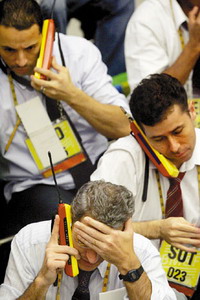George W. Bush tries to solve spreading credit crisis in US
While calming nervous investors, the Federal Reserve plowed $3.75 billion (2.78 billion EUR) into the financial system trying to stanch a spreading credit crisis that has unhinged Wall Street.

Wrapping up a summit in Montebello, Quebec with the Prime Minister of Canada and the Mexican president, Bush took the opportunity to point out that the U.S. economy remains in good shape and should be able to weather the financial storm.
"The fundamentals of the U.S. economy are strong," Bush said. "The fundamental question, 'Is there enough liquidity in our system?' And the answer is `Yes, there is,"' the president declared.
Treasury Secretary Henry Paulson also tried to strike a reassuring tone.
"We're going to work through this problem just fine," Paulson said in an interview with CNBC. He urged patience as investors reassess their appetite for risk, saying: "There's not going to be a quick solution" to some of the problems. "I think what the American people need to understand, these things take a while to play out."
Paulson, meanwhile, said the administration is concerned about soaring foreclosures and late payments, especially among people with spotty credit histories, and is exploring ways to deal with the problem.
"We're really focused on the subprime market, and we're really focused on the homeowners - mortgage holders - who are in danger of losing their homes," Paulson said. The administration "is thinking through policy options to address that segment of the market," he added, but provided no specifics.
After a five-year boom, the housing market turned to bust last year. And the combination of higher interest rates and weaker home values have clobbered homeowners, especially those with higher-risk subprime mortgages. Mounting defaults have forced some lenders out of business. Credit problems have spread to other borrowers. Nervous lenders have tightened standards, making it harder for individuals and companies to obtain credit - the lifeblood of the economy.
Increasingly restrictive lending conditions can crimp peoples' ability to buy big-ticket goods, such as homes, cars and appliances and it can chill businesses' capital investment and hiring. Such a scenario would slow overall economic growth.
Paulson acknowledged the turmoil "will in all likelihood ... take a toll out of economic growth" but predicted the economy would still make its way safely through the troubles.
Trying to further stabilize wobbly markets, the Federal Reserve on Tuesday pumped another $3.75 billion (2.78 billion EUR) into the financial system. It was the latest in a series of cash transfusions that have topped more than $100 billion (74.03 billion EUR) since last week. That's aimed at helping banks and other institutions get over the hump and carry out their business more smoothly.
In another move Tuesday, the Fed cut the fee bond dealers pay to borrow Treasury securities directly from the central bank. It was temporarily lowered from 1 percent to 0.5 percent.
In the past few weeks, financial markets in the U.S. and around the globe have been shaken by fears about spreading credit problems that started with home mortgages. Investors are worried that these problems will infect the larger financial system and possibly hurt the U.S. economy. As a result, stocks on Wall Street have careened wildly.
Senate Banking Committee Chairman Christopher Dodd, meanwhile, urged Federal Reserve Chairman Ben Bernanke to use "all the tools available" so the credit crisis and home mortgage mess don't undermine the national economy.
Dodd, a Connecticut Democrat seeking his party's presidential nomination, did not specifically ask Bernanke to lower a key interest rate in a meeting he had privately with the Fed chairman and Paulson. Dodd, did, however, urge policymakers to do all they could to ease the credit crunch, he said after the meeting.
So far the Fed has been reluctant to reduce the key rate, called the federal funds rate, which has stood at 5.25 percent for more than a year. It's the interest banks charge each other on overnight loans and is the central bank's main lever to influence economic activity. A cut in the funds rate would cause commercial banks to lower their prime lending rate charged to many consumers and businesses.
The odds, though, are growing that the Fed will cut the funds rate on or before Sept. 18, its next regularly scheduled meeting, analysts say.
While a lower funds rate could have positive implications, Dodd stressed that he did not want to appear to be putting "political pressure on the Fed."
Dodd said he welcomed the Fed's steps thus far to deal with the credit problems.
In addition to injecting billions of dollars into the financial system, the Fed last week sliced its discount rate - the rate it charges banks for direct loans - to 5.75 percent.
Fed officials also have been urging banks to borrow from the Fed's so-called discount window, trying to remove a stigma that it is a place for banks to turn to only in times of emergency or last resort. The Fed is now allowing loans of up to 30 days versus the normal one day.
New York Fed President Timothy Geithner and Donald Kohn, the second-highest ranking person on the Federal Reserve's Board of Governors, participated in a conference call last Friday with major investment banking firms. They suggested use of the discount window would be viewed as a sign of strength.
Paulson, on CNBC, said he has "great confidence" in the Fed but refrained from saying whether its actions thus far will be sufficient. He did say the Fed's actions will make it easier for market players to "focus on risk" and get themselves straightened out.
On Capitol Hill, some Democrats would like to see government-sponsored mortgage giants Fannie Mae and Freddie Mac - which are recovering from accounting scandals - play a larger role in the mortgage market.
Subscribe to Pravda.Ru Telegram channel, Facebook, RSS!


